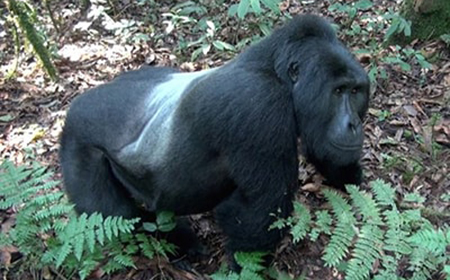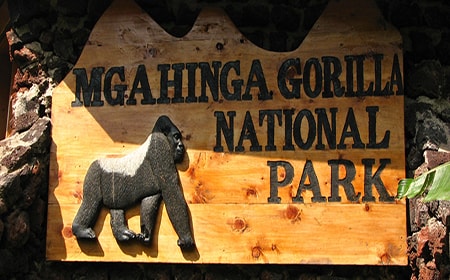Gorilla Parks in Uganda – Mountain Gorilla Habitats
Gorilla Parks in Uganda are only two and include Bwindi Impenetrable National Park and Mgahinga Gorilla National Park. These parks are found in south western side of Uganda and are famous for gorilla trekking safaris especially Bwindi forest. Bwindi, the one with the highest number of gorilla families out of the four gorilla national parks in the region is among the UNESCO World Heritage Sites in Uganda. Bwindi and Mgahinga are two of the four mountain gorilla national parks in the region. The other 2 include the Volcanoes National Park in Rwanda and Virunga National Park in the Democratic Republic of Congo. Gorillas in these parks are organized into habituated groups or families that are available for tracking by gorilla visitors. To enter the parks, one must have a gorilla permit booked through a tour operator well in advance. The Uganda Wildlife Authority (UWA) is in charge of managing all the national parks in Uganda is responsible with issuing the permits to trek gorillas. The mountain gorilla habitats are also among the major tourist attractions in Uganda because of their gorilla trekking safaris that take place at these destinations every day throughout the year.
Access to the Gorilla Parks
Majority of Gorilla safaris in Uganda have three starting points. One can book a gorilla trip, fly into Kigali in Rwanda and trek gorillas in Uganda going through either Gatuna or Cyanika border points. Such safaris are under Uganda gorilla trekking from Kigali and are common. Alternatively, visitors may fly into Uganda and take scheduled flights from Entebbe to Bwindi Forest by land at Kihihi Airstrip or Mgahinga via Kisoro town. One can also charter a plane from Entebbe to any of the two parks, visit gorillas in the jungle and fly back. And the third is by road from Kampala or Entebbe to the gorilla dwelling places. These trips from Kampala to Bwindi last a minimum of 3 days since the distance is longer and takes the biggest portion of the day compared to those safaris that start from Kigali to Uganda.
MOUNTAIN GORILLA PARKS IN UGANDA
Bwindi Impenetrable National Park, the home to half of the world’s mountain gorillas is found southwestern Uganda on the Rift Valley edge. With several gorilla families available for tracking, gorilla trekking is the major tourist activity in the park. Widely known as an “impenetrable forest” the park protects approximately 500 mountain gorillas which is loosely half of the world’s number of the engendered primates.
To trek gorilla in Bwindi or any park, you have to to know what to pack for the safari. Reading the proper gorilla trekking rules and regulations is also very vital for visitors and the primates themselves. The park also several mammal, plant and bird species as well as pygmies and wonderful communities that facilitate nature, community and cultural tourism among others. Read More about Bwindi Impenetrable National Park.
Mgahinga Gorilla National Park found in southern western Uganda in Kisoro District is a habitat to Mountain Gorillas in Uganda. The 33.7 square kilometers park features 3 extinct volcanoes (Mount Gahinga, Sabyinyo and Muhabura), mountain gorillas and golden monkeys. The extinct volcanoes are Mgahinga’s most striking features.
Mgahinga is a portion of the enormous Virunga Range which lies along the border area of Uganda, Rwanda and DR Congo. Mgahinga forms a fragment of the considerably bigger Virunga Conservation Area which comprises of neighboring parks in the three countries. Gorilla Trekking with the Nyakagezi group, the only gorilla family in Mgahinga plus golden monkey tracking and mountain hiking are the tourist activities in the park. Read More for Mgahinga Gorilla National Park details.
Protecting Mountain Gorilla Parks in Uganda
Uganda is home to nearly half of the world’s remaining mountain gorillas, primarily found in Bwindi Impenetrable National Park and Mgahinga Gorilla National Park. These parks are crucial to the survival of this endangered species and play a significant role in conservation, biodiversity, and the country’s ecotourism sector. However, protecting mountain gorilla parks in Uganda is an ongoing challenge that requires a combination of conservation strategies, government intervention, community involvement, and international support.
1. Conservation Efforts and Anti-Poaching Measures
One of the most critical aspects of protecting gorilla parks is the fight against poaching and illegal wildlife trade. Although gorillas are not typically targeted for bush meat, they can be unintentionally caught in snares meant for other animals. The Uganda Wildlife Authority (UWA) and other conservation organizations have deployed ranger patrols throughout the parks to remove snares, monitor gorilla groups, and prevent poachers from entering protected areas. Rangers are trained in wildlife monitoring, data collection, and rapid response in case of any threats to the gorillas. Additionally, sniffer dogs have been introduced at border points and key locations to detect illegal wildlife trafficking.
Furthermore, Uganda has implemented strict penalties for poaching. Under the Wildlife Act 2019, poachers and traffickers face heavy fines and long-term imprisonment if found guilty. These legal deterrents are meant to discourage illegal activities and emphasize the seriousness of wildlife protection.
2. Habitat Protection and Reforestation
Mountain gorillas thrive in dense forests, which makes deforestation and habitat destruction one of the biggest threats to their survival. Many communities surrounding gorilla parks depend on forests for firewood, agriculture, and timber, leading to encroachments and land degradation. To combat this, the Ugandan government and conservation groups have launched reforestation programs that restore degraded areas while also providing alternative sources of fuel and income to local communities.
One such initiative is the “One Million Trees” project, which encourages locals to plant trees in buffer zones to prevent further deforestation. Additionally, the government has strengthened laws against illegal land clearing and continues to work with local authorities to prevent encroachments into gorilla habitats.
3. Human-Gorilla Conflict Mitigation
As gorilla populations grow, their interactions with humans also increase, sometimes leading to conflicts. Gorillas occasionally venture outside the parks, raiding farms and causing losses to local farmers. This can create resentment and reduce community support for conservation efforts.
To address this issue, conservation organizations have introduced human-wildlife conflict mitigation programs. One of the most effective solutions has been the establishment of buffer zones—areas with crops like tea that gorillas do not eat, preventing them from crossing into farmland. In addition, electric fencing has been tested in some areas to keep gorillas from raiding crops. Conservationists have also introduced compensation schemes, where farmers who suffer crop losses due to gorillas receive financial support to minimize economic hardship.
Another innovative solution is the use of gorilla guardians, local volunteers trained to track gorillas and gently guide them back into the park whenever they stray into community lands. These guardians play a crucial role in reducing tension between communities and conservationists.
4. Community Involvement and Benefit-Sharing
One of the most important aspects of protecting mountain gorilla parks is ensuring that local communities benefit from conservation efforts. Without local support, conservation projects often struggle to succeed. Recognizing this, Uganda has implemented a revenue-sharing program, where 20% of gorilla tourism revenue is allocated to community development projects. These funds help build schools, hospitals, roads, and clean water systems, improving the quality of life for people living near the parks.
In addition, many former poachers and unemployed youth have been given opportunities to work in conservation and tourism. They receive training to become porters, tour guides, or artisans, producing handicrafts sold to tourists. This economic empowerment encourages locals to see gorillas as a valuable resource worth protecting rather than a threat to their livelihoods.
Several community-based tourism initiatives have also been launched, such as home-stay programs where visitors can stay with local families, learn about their culture, and support small businesses. By creating a direct economic link between tourism and local people, these programs promote conservation awareness and encourage long-term protection of gorilla parks.
5. Disease Prevention and Veterinary Care
Gorillas share about 98% of their DNA with humans, making them highly susceptible to human diseases, especially respiratory infections. Even a common cold can be fatal to gorillas, which is why strict health protocols are in place for tourists visiting gorilla parks. Visitors must wear face masks, maintain a distance of at least 7 meters from the gorillas, and are not allowed to visit if they are sick.
The Gorilla Health and Community Conservation Center, also known as the Gorilla Doctors, provides veterinary care to sick and injured gorillas. Vets regularly monitor gorilla families, treating injuries caused by snares or infections, and conducting health check-ups. The organization also educates local communities on the importance of hygiene and sanitation to reduce disease transmission between humans and wildlife.
6. International Partnerships and Funding
Conserving mountain gorillas requires significant financial and technical resources, which Uganda often receives from international organizations like the World Wildlife Fund (WWF), the International Gorilla Conservation Programme (IGCP), and the Dian Fossey Gorilla Fund. These organizations provide funding for research, ranger salaries, community projects, and anti-poaching efforts.
In addition, global campaigns such as “Adopt a Gorilla” programs allow individuals worldwide to contribute directly to gorilla conservation. Tourists visiting Uganda also play a crucial role, as a portion of their gorilla trekking permit fees (which cost between $700 and $800 per person) is reinvested into conservation efforts. Without international collaboration, it would be challenging to maintain the high level of protection needed for these endangered animals.
Protecting mountain gorilla parks in Uganda is a complex but essential task that requires a multi-faceted approach. Through strict anti-poaching measures, habitat conservation, human-gorilla conflict mitigation, community involvement, disease prevention, and international support, Uganda has made remarkable progress in securing the future of these majestic creatures. However, continued commitment and innovation are needed to ensure that gorilla populations continue to thrive in their natural habitats. By working together—government agencies, conservationists, local communities, and tourists—Uganda can remain a global leader in gorilla conservation while also benefiting from the economic advantages of ecotourism.


